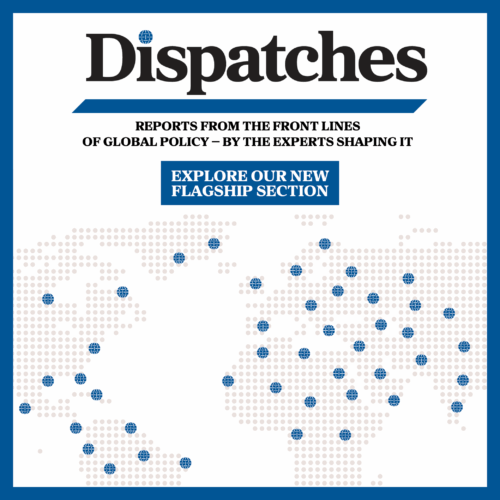European members of NATO view America’s pivot toward Asia anxiously, seeing it as the beginning of a U.S. withdrawal from Europe. They should not be concerned. Instead, European members should see America’s turn to the Asia-Pacific region for what it is: the most consequential opportunity to bolster the trans-Atlantic link since the attacks of September 11, 2001.
In fact, arguments that NATO needs to metamorphose into a Pacific actor are unfounded. It is one already. Amid angst over the euro and a resurgent Russia, the west coast of North America may be the most overlooked piece of NATO’s real estate. Yet by virtue of its geography, the Pacific coast furnishes the alliance with a vital springboard into—and enduring interest in—Asian security.
NATO’s challenges are global, not regional, in scope. The alliance recognized the international character of its security in Lisbon in November 2010 when nations endorsed the new strategic concept. Smart defense—NATO’s means of maximizing operational efficiencies—is a response to the rapidly changing security environment confronting the alliance. Globalization and technology have changed the character of the international system; events in Asia affect the trans-Atlantic community forcefully and immediately and vice versa. What happens in the South China Sea affects the alliance as much as what takes place in the English Channel. Consider the global supply disruptions that stemmed from the Japanese earthquake and tsunami in March 2011.
Yet the alliance does not understand Asian security challenges.
How can it? NATO lacks sufficient presence in and engagement with the region. Unfortunately, because the alliance does not have the ability to gain a first-hand perspective, NATO officials guide their statecraft solely on information from third parties. Asia is too important and complex a continent for the alliance to view through the lenses of others. NATO’s misperceptions are, moreover, rooted in a centuries-old colonial bias; while European members talk partnership, in practice many of the old Continent’s elites still view Asia primarily as a fruitful source of commercial enterprise.
A Tokyo Liaison
While Australia is an obvious interlocutor and South Korea’s burgeoning relationship with NATO is invaluable, Japan offers the alliance special and unique benefits. Birthed from the ashes of WWII, NATO and Japan are natural partners—some might even call them cousins. Japan is the most powerful conventional military actor in the region and has extensive experience working with NATO. Moreover, it is a democratic nation in the heart of Asia that embraces the free market, has the third-largest economy in the world, and espouses the same values of freedom and prosperity that make the alliance great.
Alliance engagement with Japan begins with America. Japan’s relationship with the United States is paramount: the Japanese will not enter a security relationship that even remotely jeopardizes the Japan-U.S. defense alliance. The best way to achieve NATO-Japan cooperation is through bilateral meetings, with the United States ambassador to NATO leading the effort informally. A NATO-Japan partnership would be much more effective when coordinated with the U.S. Departments of Defense and State along with the Japanese Government.
NATO would find willingness to cooperate on both sides. Japan wants to engage with the alliance. Despite domestic constraints, Tokyo recognizes that its position relative to the region, and the world, is changing. It sees NATO as a natural complement to its relationship with the United States: NATO is democratic, consultative, supportive of the U.N. and perceived as a “force for good” in the world. According to one Japanese security expert, Japan’s aims toward the alliance are fourfold: to gain “a political partner, operational partner, another means of co-operation with the U.S., and . . . a multilateral school.” Furthermore, Washington has shown a keen interest in assisting the alliance if it were to seek greater cooperation with Tokyo.
The culmination of an invigorated NATO-Japan relationship should be the establishment of a liaison office in Tokyo. A small staff in such a global capital would allow the alliance to cultivate the long-term relationships it needs if it is to be viewed as a major actor in the pan-Pacific region.
NATO’s Pacific Moment
Alliance engagement in Asia will create controversy. No matter how NATO chooses to pursue an Asia-Pacific strategy, doing so will be a source of concern for other actors in the area and for some in Europe. Pushback from other nations in the region will be a natural response, but the alliance should be prepared for that outcome and nevertheless stride ahead, always mindful that building a meaningful partnership takes time, effort, and investment.
A far riskier option for the alliance is to stay out of Asia. In doing so, it would lose the opportunity to play a constructive role in the security of the world’s emerging basin of consequence.
America’s pivot is a significant opportunity for NATO. The trans-Atlantic community has partners around the world, but Japan is the alliance’s strongest friend in Asia. In short, to navigate the challenges of a changing security environment effectively, NATO must be regional in character, global in stature and Pacific in direction.
Barry Pavel is director of the International Security Program and director-designate of the Brent Scowcroft Center on International Security at the Atlantic Council. Jeffrey Reynolds is part of the Strategic Engagement team at NATO HQ Supreme Allied Command Transformation and member of the Atlantic Council Young Atlanticist Working Group. This blog was originally posted in the National Interest.
